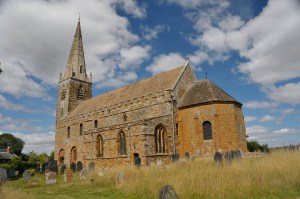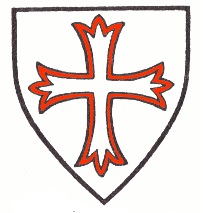All Saints, Brixworth is a building of truly international importance. It has been described as the ‘finest seventh century building north of the alps’ – and its construction remains an enigma.
All Saints features a medieval annex to the 7th Century main fabric, known as the Lady Chapel – it is still used for early morning Sunday services. Sir John de Verdun (d1274) is thought to have been responsible for the building of the Verdun Chapel, and his tomb survives.
When in the fifteenth century the Harrington’s came into possession of the Manor of Brixworth, the church came under their control – and features in the lives of the Harringtons born in the village.
Sir Richard Harrington (born c.1399 – died 17 Aug 1462) marries the Verdun heiress to the Wolfage Manor estates, and adopts the White Lion Rampant from the Verdun line onto his livery, though he is buried up north in the Friary Church in Lancaster.
His son, Sir William (Born c. 1425 at Wolfage Manor – died 14 Aug 1488 aged ~63) is not recorded as buried in the Friary at Lancaster, and is suspected as being buried in All Saints, Brixworth. His son and heir Sir James Harrington was definitely entombed at All Saints, his will states this, and his tomb was recorded by Thomas of Guilsborough in the following century – though it does not seem to have survived the reformation.
Whilst the tomb of Sir James has not survived, the stained glass window does carry a connection to the Harringtons – the White Lion Rampant of the Verdun line is displayed on the east window above the Chapel Altar.

Note the Medieval IHC Monogram. In the Latin-speaking Christianity of medieval Western Europe (and so among Catholics and many Protestants today), the most common Christogram became “IHS” or “IHC”, denoting the first three letters of the Greek name of Jesus, IHΣΟΥΣ, iota-eta-sigma, or ΙΗΣ. The Greek letter iota is represented by I, and the eta by H, while the Greek letter sigma is either in its lunate form, represented by C, or its final form, represented by S http://en.wikipedia.org/wiki/Christogram
Some recent research supplied by Philip Beddows suggests a different theory for the adoption of the Chess Rook Gules on the Harrington Livery. Philip theorises that the silver lion rampant with the chess rook is from the arms of his wife’s ancestor, Sir Thomas de Verdon, who appeared with his brother Sir John de Verdon at the great Tournament gatherings at Stepney in 1308 and Dunstable in 1313. See from a transcription from the Battle Abbey Roll that appears on this webpage:




#1 by Irene Heller on July 5, 2015 - 10:22 am
I saw your company at a recent Battle of Northampton Taster Day held in Delepre Abbey.
I was visiting friends who live in Northampton and see from your website that you travel around the country. I am looking at doing something locally in Kent which could involve your company and wondered if you could give me an indication of costs and what a day would entail.
I look forward to hearing from you. Regards Irene